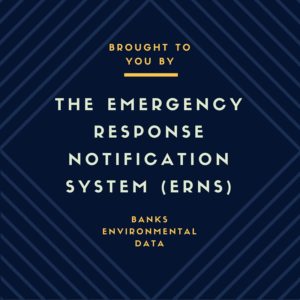
According to EPA, Emergency Response Notification System (ERNS) is the national database used to store information on releases of oil and hazardous substances. Before the establishment of the ERNS program, there was no centralized source of information capable of displaying all oil and hazardous substance releases that were being reported to the various offices of the federal government. ERNS provides a comprehensive, readily available method to collect reports and assess potential hazards across multiple federal agencies.
New records are entered into the ERNS database when a person sees a potential hazard and reports their findings to EPA or similar authorities. The person reporting the hazard provides information about the type of hazard they are reporting, its location and the source of the incident. Because of this data collection process the ERNS database is limited in the information it can provide. For instance, once records are entered into the ERNS database it may not be edited/looked at ever again unless an EPA region is involved in the response action.
Due to the manner that release events are reported and documented, the ERNS database can be a tricky and oftentimes frustrating set of information to dig through. Many entries are incomplete or have no usable information that can tie the incident to a particular time or place. This makes sorting the database into useful information a specialized process that requires a unique methodology.
In order to analyze this enormous volume of federal spill data, Banks has created a special process for the ERNS database in order to pinpoint only the most relevant pieces of information. We take the most detailed records – those with clear, full addresses – and place them at their indicated location within our mapping system. Records with incomplete information are then sorted into two categories: those we can confidently map based on clues within the record’s data and those that cannot be mapped. When researching a Phase I Site Assessment, ERNS records that don’t have enough information to be plotted on a map are referred to as orphan sites, or unmapped records. Within these unmapped records, there may be ERNS that cannot be confidently placed on the map but have more general information on what area of a city they are in. These we can rule out of some reports and purposefully include as unmapped sites in others. In these ways, we take care to only present the most relevant records individually selected for each site.
Ian Holt
Program Manager – Water Wells
iholt@banksinfo.com
